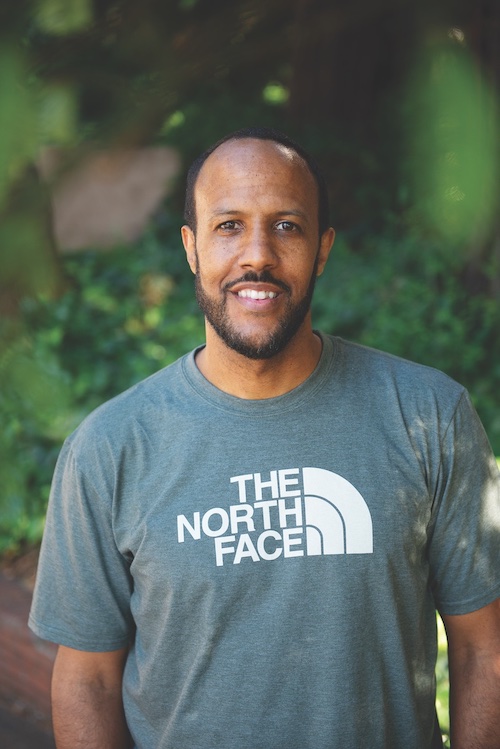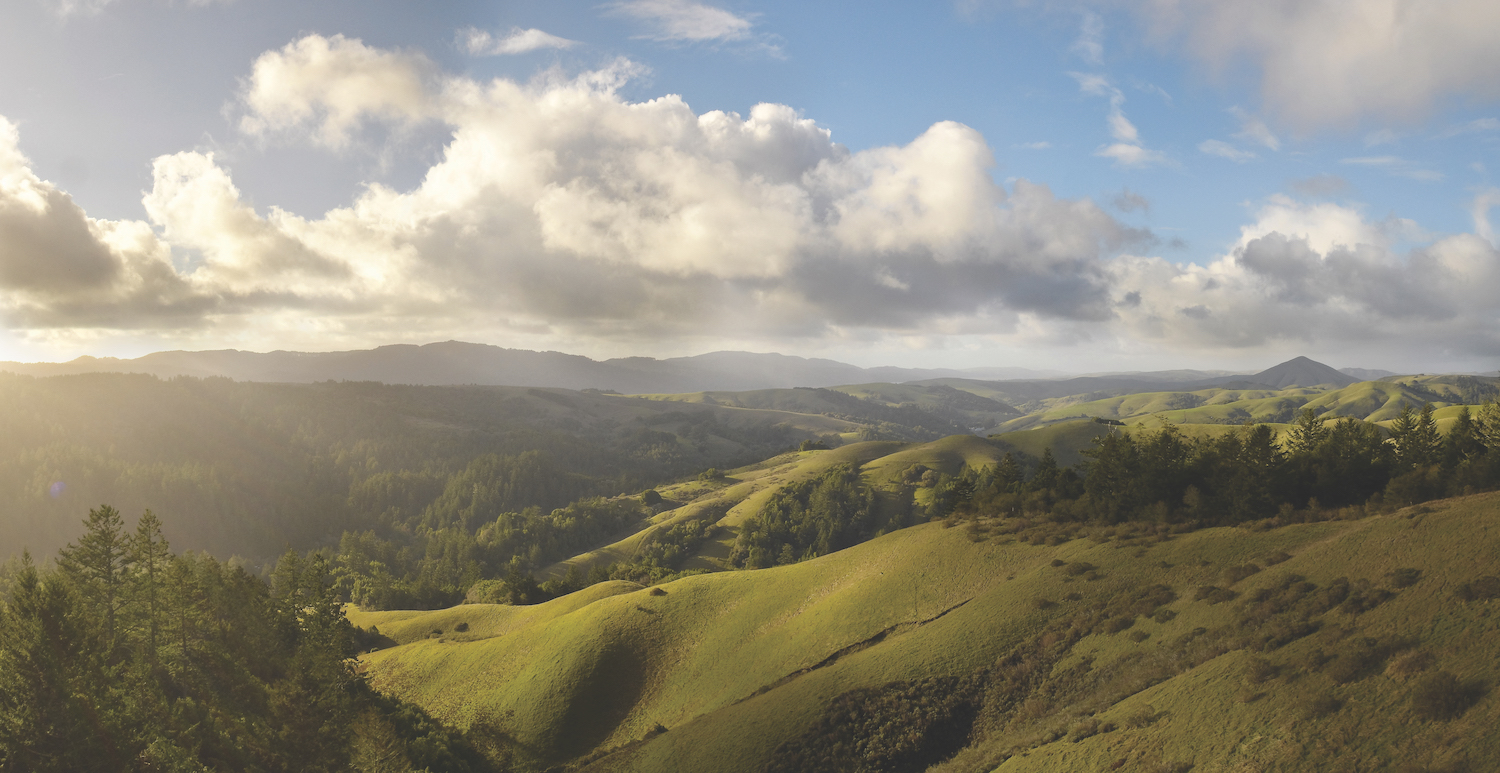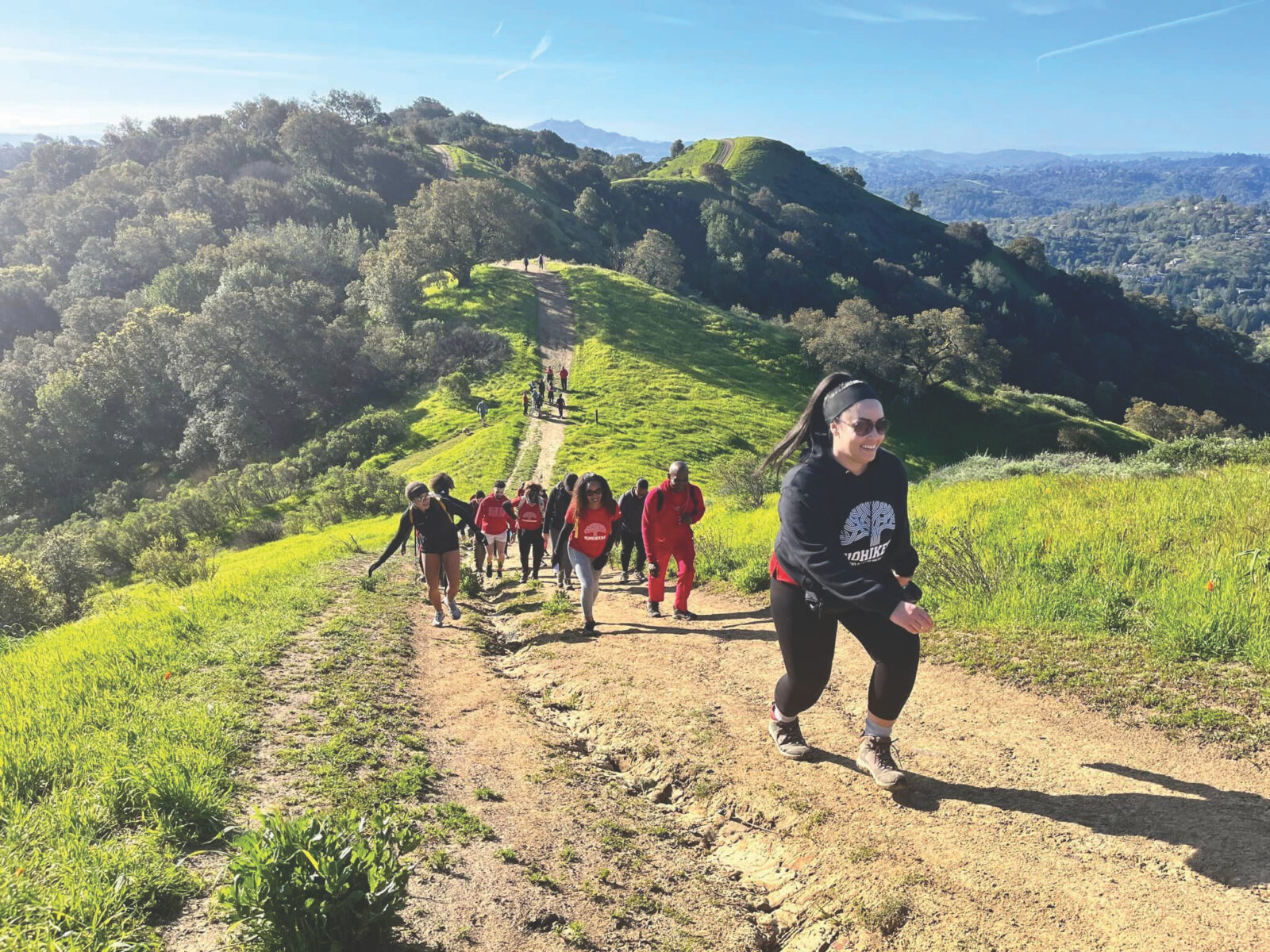The redwoods stand tall in the mist near Samuel P. Taylor State Park in Marin County. On a December morning, golden sunlight accents the curve of Sir Francis Drake Boulevard, meeting the earth through the gaps in the trees. As I drive around a bend in the road, a huddle of people wearing black shirts and standing to the side of a dirt parking lot come into view. Their gear emblazoned with “510” in bold lettering is a dead giveaway. This is 510 Hikers.
A crowd starts to form minutes after I park. Warm shouts and laughter fill the cold morning air. It’s like an orchestra tuning before a concert—all the members taking their places, saying hi to their stand-partners, and grinning as the energy simmers and bubbles, everyone eager for the music to begin. If 510 is an orchestra, then Nick Collins, the group’s founder and leader, is its maestro, readying everyone for the downbeat.
At 8:30 a.m. Collins leads us into a circle for what one hiker calls the weekly “pregame speech.” Around me stand 30 or more people of all ages and races. Brown hands clasp walking poles. Some members don beanies to ward off the cold. Plumes of warm breath fill the air as the hikers laugh and chat. Looking around the circle, I see more varieties of outdoor gear and boots than I’ve ever seen before. The black 510 Hikers shirts stand out as the one constant.
On hikes with more newcomers or younger kids, Collins will make a point of asking everyone to stay on the trails, pick up trash, not feed animals, and in general, in his words, “leave no trace.” But most people at today’s event have heard it before, so after Collins welcomes everyone he asks for a moment of silent introspection, there’s a group photo—a ritual that inaugurates every Saturday—and the hikers are off.
“This is community grown and based and developed,” Collins says, “and there’s an authenticity that comes out of it that can’t be copied.”

Collins has led 510 hikes for almost 10 years, facilitating thousands of people around the Bay Area, many of whom are Black and brown locals, to head out on a trail for their first time. Although 510 Hikers is now a multi-thousand-person community, it’s also a one-man nonprofit, “it wouldn’t be what it is without Nick,” says Roxanne Yameogo, who has been participating for around three years. “It takes a special person to dedicate every Saturday of their life to organizing a hike.” Together the group has charted more than 500 trails on AllTrails.
510 Hikes has been sponsored and supported by REI and GU Energy Labs, held sponsored races, led trips abroad, and organized drives collecting food and household goods to serve local communities in need. But above all, as surely as one foot follows the other, there is a hike each Saturday.
Born and raised in East Oakland, Collins spent his childhood hiking, picnicking, and playing at Joaquin Miller and Redwood Regional parks with his parents and siblings. After moving to Long Beach for college, where he ran track and field, Collins returned to the Bay Area, and he now works for a publishing company. A desire to lead a healthier life brought him back to the trails he visited as a kid. “I’d become heavy, and I’d walk into a gym and I’d feel lost,” says Collins, now 49. “But I did remember the routes of hiking, and I had that muscle memory of going into the woods.”
Sign up today!

The first time he invited friends to hike with him, “none of them came!” Collins says, laughing. “Not one! It was hilarious.” So the next time, he posted an invitation to friends through Facebook, and 510 Hikers, now a Facebook group with more than 12,000 members, took root. Around the same time, Collins was walking the popular trail to Mission Peak in Fremont with a friend, also a Black man. “We were like, ‘Jesus Christ! There’s not one single Black person on this trail.’ We were there for like two hours and there were maybe a couple hundred people,” Collins says. “This has to change.”
In Samuel P. Taylor, we follow Bill’s Trail, and the smell of wet bay leaves, camphoric and sharp, fills my nostrils, and cool moistness settles on my skin. Big-leaf maple leaves, autumnal in color, flatten silently below my feet, and California hazelnut, Himalayan blackberry, and ferns tangle in wet patches along the trail. Hikers walk single file, and the bubbling energy from the parking lot rises to a rolling boil as hikers laugh and shout, whooping at each other from different points of the trail. As we begin to climb, hikers cheer as they pass each other on switchbacks. They pull out whistles, gifted to the group by a private donor, and trill jubilantly as the group ascends. The hikers pause only for group photos, holding the bright yellow, dinner-plate-size maple leaves to their faces and grinning broadly as friends snap shots. Everywhere on the trail, people are hugging and laughing, talking and listening. “A lot of people like this formula, whatever this magic is,” says Yolanda Barnes, an avid 510 Hiker and a counseling administrator at Mission College in Santa Clara.

As an outdoor community dedicated to increasing inclusiveness on the trail, 510 Hikers is something of a rarity in the Bay Area. Black and brown people are seemingly underrepresented in the outdoors compared to their local populations, although local data is scarce. In a voluntary mail-in survey of visitors to the Golden Gate National Recreation Area (GGNRA) conducted by the National Park Service (NPS) in 2016, of the roughly 1,500 respondents, 86 percent were white, 10 percent Asian, and 2 percent Black.
Some conservation organizations and land management agencies in the San Francisco Bay Area and beyond have been trying to understand the reasons behind those statistics and to deliver on DEI aims—particularly within the last five years. “George Floyd’s murder in 2020, and the pandemic and other pressures at the time, became a tinderbox that lit a lot of fires,” says Annie Burke, executive director of TOGETHER Bay Area, a regional coalition working toward climate resilience and equity in the Bay Area. “It was this chemistry of pressures that spurred a lot of change.” Many reforms, Burke explains, “are happening below the radar,” through hiring policies, systems-level shifts, efforts to return land to Indigenous communities, and more. But, Burke says, “there’s so much more work to do.”
Whether there’s been a change in the racial diversity of visitors in Bay Area parks since the 2016 survey may become evident later this year. A demographic survey of East Bay Regional Park District visitors will soon be published by San Francisco State University in partnership with the district. And a more recent usage survey of the GGNRA, with data collected in 2023 by NPS, is scheduled to be published in 2024. A glimpse of statewide numbers is newly available. A voluntary survey of California State Park visitors who obtained free park passes from a California public library between May 2022 and January 2024 showed that of the nearly 6,000 respondents 33 percent identified as white, 28 percent as Latino, 22 percent as Asian, and 3 percent as Black.
Collins feels that with 510 Hikers hitting the trail every Saturday, Black people in the Bay Area and beyond who previously “had to make a decision—do I not go hike and stay with my community, or do I go hike and leave my community?”—now have a choice. “It’s just a nice space to be in—it’s this feeling that’s very hard to put to words that we get when we see our fellow Black hikers on the trail,” says Barnes.
Some other groups in the Bay Area also focus on racial diversity or wellness in the outdoors, including Latino Outdoors, Outdoor Afro, H.E.A.T. (Hiking Every Available Trail), Family Wellness Group, and 209 Hikes. 510 is intentionally open to anyone, regardless of ethnic background, age, or physical ability. “We are content-of-character based,” says Collins, referencing Dr. Martin Luther King Jr.’s speech. “I have a dream that my four little children will one day live in a nation where they will not be judged by the color of their skin but by the content of their character.”
As a second grader, Collins memorized King’s speech during Black History Month at his Oakland elementary school, and the words have stuck with him. “Though there’s a frequency and a vibration involved [with] getting people of like skin or like gender together or like orientation together, there’s a whole ’nother vibration that occurs when you’re getting people of the same spirit together,” he says. Part of 510’s inclusive ethos arises from Collins’s upbringing as a Black, transracial adoptee raised by white parents. “I grew up with this mindset of diversity is only helpful.”
Hikers echo Collins’s appreciation for the 510 community. “There’s something about the people that stay,” Barnes says. “This is like the safest place ever, being in the outdoors and with these people who genuinely care—I’ve only known them for three years, but I feel I’m closer to them than some of the folks I’ve known all my life.” Barnes, who attends roughly 40 out of the 52 weekly hikes each year, says she has cried many times on the trails, deep in conversation with other 510 members. These weekly hikes are “my church, my therapy,” she says. “The hike has to happen.”


Hikers from different backgrounds find community on the trail with 510. (Left, Jose de la cruz; right, Raymond “Circus” King)
Hikers range in age from six to nearly 80 and often number around 100, depending on the Saturday, trekking eight to 10 miles, though shorter routes are almost always available. “We got walkers, we got runners, we got joggers, we got hikers, we got a very broad range of fitness levels that everybody can relate to,” says Raymond King, a 510 Hiker and personal fitness trainer. There’s no set speed. There’s no pressure to move at any pace other than your own—not even when the hikes get intense.
The sun burns away the morning’s cool misty haze, and we leave behind the smell of bay leaves and the earthy musk of the redwood undergrowth. We hike under direct sunshine, clear skies, and sweeping views of Point Reyes National Seashore as we make our way up Barnabe Peak. The hikers’ huffs and puffs mingle with the ever-present laughter and conversation, and we march upward single file, bent double and legs aching, climbing together.
“I’m humbled,” says King, reflecting on his years of hiking experiences with 510. “People like myself, being African American, we’re not exposed to these different trails.” King recalls wearing basketball shoes to hike with 510. “I remember having pain in my ankles and my calves, and someone told me, ‘Why don’t you get some hiking shoes?’ … Being from a basketball background, I didn’t know what that was. I got some trail shoes and that changed everything.”
King first ran into 510 Hikers while at Alamere Falls in Point Reyes nearly nine years ago. “You think of trails, you think of solitude, peace, nobody there—and this is the total opposite,” King says, recalling that chance encounter. “Everybody was laughing and smiling.” He tagged along with the group that day and has been a regular ever since. “It was people who looked like me—a lot of minorities, African Americans, Latinos, Asian people. I was totally in shock.”
Prior to 510 Hikers, King often hiked alone, and although he still runs ahead of the group on their weekly hikes, he credits the group with boosting his self-confidence in the outdoors, to overcome his fear of heights, for example. When the group hiked Half Dome for the first time, King recalls saying to Collins, “I’m like, ‘Man this is crazy—bro, Imma die!’” But with encouragement from Collins and others, King successfully scaled Half Dome. “That’s what the group does,” says King. “It gets people to do things that they didn’t think they could do.”
Showing up with a community is important for other reasons too, Collins says. “There’s something to be said about walking somewhere and knowing that you’re not alone, and other people knowing you’re part of a group…You get treated better.”
Though 510 has grown immensely, building a diverse Bay Area outdoor community and hiking almost weekly, there have been hurdles along the way. “We’ve had a couple experiences with park rangers in the past,” says Collins. “We felt like there was a little bit of racial tension that led to those experiences, and [that’s] unfortunate.”
Collins recalls that in July 2018, he was issued a ticket at the Purisima Creek Redwoods Preserve by a ranger from the Midpeninsula Regional Open Space District. The day before, Collins had requested a permit for hiking at Purisima that was denied. Another large group was already permitted for the same day and parking was limited, according to Midpen, and Collins was issued a 49-person permit for another preserve that was nearby. Permits are required for groups of more than 20 people.
Collins went to Purisima with 510 Hikers and writes that he was “not sure how many we had but it was around [the limit of 20].” Midpen maintains he had “approximately 50 or more people.” Collins was cited for not adhering to his permit, and 510 Hikers gathered at the other preserve.
The encounter remains “a sore spot that offended me,” Collins writes. “Even if we were close to the max number that day or even beyond, they could have easily just asked us to leave. We hadn’t even started hiking yet. Hard to share [the] energy that we were given by the ranger there . . . But it was aggressive and unnecessary.”
Collins adds that “the trails out there from my experiences are 99% white. I’ve been to those trails no less than 20 times over the past 10 years and have seen maybe nine black people on those trails. Part of the reason for that is a result of people like the sheriffs [rangers] we met that day who were quick to tell us to leave and give me a ticket.”
Midpen public affairs specialist Ryan McCauley says: “We definitely wouldn’t want any group to feel targeted or anything like that—our open spaces are free to everyone, for everyone. I’m happy this is being brought up…I can understand that sort of perception and where they’re coming from.”
Collins appealed the ticket and the court dismissed it in July 2020. In the years since, 510 has continued to hike at Purisima Creek Redwoods Preserve as well as other Midpen preserves. “We’ve gotten past that, and we feel like, in the past couple of years, we’ve had a different energy from park rangers,” says Collins.
After the climb comes the view. Visible from the top of Barnabe Peak, the Point Reyes peninsula and Tomales Bay sprawl to the west, Mount Diablo to the east, and Mount Tamalpais to the south. Hikers pause for more group photos, beaming, arms around each other.
The community at the top of Barnabe Peak has blossomed organically from the weekly hikes, offshooting into countless group chats with names like “Party Peoples,” group dinners, white elephant parties, Super Bowl parties, and skydiving outings. People have met, fallen in love, and had kids after meeting through 510, and many regulars like Barnes and Roxanne Yameogo now carpool to the Saturday gathering.
“People are really seeking connection right now. People are lonely, and I think sometimes people are embarrassed by that—no one wants to admit that it’s hard to make friends—but everybody has the same issue,” says Yameogo, an accountant for an Oakland start-up who found 510 after moving to the area from the Peninsula. “I was craving that connection, and what I feel from other people is they’re also craving that connection … we all want the same thing.”
Though 510 Hikers is based in the Bay Area and most of the hikes take place locally, they have also traveled and taken to the trail in Washington State, Hawaii, Arizona, Utah, Jamaica, Canada, and Mexico, with more trips on the books for 2024. Yameogo joined 510 on its trip to Banff, Canada, which involved a lot of karaoke, cooking, and games such as Left, Center, Right, in addition to—of course—a lot of hiking.

The burbling energy of earlier in the day eases into a tired contentedness as the hikers spread out and walk silently over a carpet of yellow maple leaves, making their way back to the parking lot. Tanoaks and alders border the trail and hikers make the slow return, more than eight miles logged on AllTrails. People reach their cars in small groups and depart on their own, some going to brunch together, others off to their families, some to walk more.
“Each hike is almost like this march of sorts, a model of what we want to see in nature—who we want to see in nature,” Collins says.
And, in the end, “we’re not out there to solve the racial tension of the world,” Collins says. “Martin Luther King Jr. couldn’t do it. How am I gonna do it? But what we can do is, within the community, be a model towards what we believe feels like less racial tension.”
Looking long term, Collins hopes the day comes when 510 Hikers isn’t needed. “It’d be great to sit around with my two boys and talk about how there actually was a need—that I used to go on these hiking trails that had no Black and brown people out there, and have them say, ‘No way, Dad!’” Collins laughs. “Batman would love to retire from Gotham City, right?”
Until then, though, as Yameogo says, “the trail is what connects us,” and 510 hikes on.





